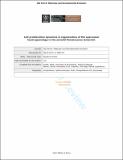Files in this item
Cell proliferation dynamics in regeneration of the operculum head appendage in the annelid Pomatoceros lamarckii
Item metadata
| dc.contributor.author | Szabo, Reka | |
| dc.contributor.author | Ferrier, David Ellard Keith | |
| dc.date.accessioned | 2015-05-04T23:01:55Z | |
| dc.date.available | 2015-05-04T23:01:55Z | |
| dc.date.issued | 2014-07 | |
| dc.identifier | 117073236 | |
| dc.identifier | 139a9216-364e-4719-989f-945470e5d4b4 | |
| dc.identifier | 84901984682 | |
| dc.identifier | 000337587500001 | |
| dc.identifier.citation | Szabo , R & Ferrier , D E K 2014 , ' Cell proliferation dynamics in regeneration of the operculum head appendage in the annelid Pomatoceros lamarckii ' , Journal of Experimental Zoology Part B: Molecular and Developmental Evolution , vol. 322B , no. 5 , pp. 257-268 . https://doi.org/10.1002/jez.b.22572 | en |
| dc.identifier.issn | 1552-5007 | |
| dc.identifier.other | ORCID: /0000-0003-3247-6233/work/36423821 | |
| dc.identifier.uri | https://hdl.handle.net/10023/6620 | |
| dc.description.abstract | Regeneration of lost or damaged appendages is a widespread and ecologically important ability in the animal kingdom, and also of great significance to developing regenerative medicine. The operculum of serpulid polychaetes is one among the many diverse appendages found in the lophotrochozoan superphylum, a clade hitherto understudied with respect to the mechanisms of appendage regeneration. In this study, we establish the normal time course of opercular regeneration in the serpulid Pomatoceros lamarckii and describe cell proliferation patterns in the regenerating opercular filament. The P. lamarckii operculum regenerates through a rapid and consistent series of morphogenetic events. Based on 5-bromo-2'-deoxyuridine (BrdU) labelling and anti-phosphohistone H3 immunohistochemistry, opercular regeneration appears to be a mixture of an early morphallactic stage and a later phase characterised by widespread proliferative activity within the opercular filament. Tracking residual pigmentation suggests that the distal part of the stump gives rise to the most distal structures of the operculum via morphallactic remodelling, whereas more proximal structures are derived from the proximal stump. Our work underscores the diversity of regenerative strategies employed by animals and introduces P. lamarckii as an emerging model of appendage regeneration. | |
| dc.format.extent | 6529090 | |
| dc.language.iso | eng | |
| dc.relation.ispartof | Journal of Experimental Zoology Part B: Molecular and Developmental Evolution | en |
| dc.subject | morphallaxis | en |
| dc.subject | lophotrochozoan | en |
| dc.subject | BrdU | en |
| dc.subject | Phospohistone H3 | en |
| dc.subject | polychaete | en |
| dc.subject | QL Zoology | en |
| dc.subject.lcc | QL | en |
| dc.title | Cell proliferation dynamics in regeneration of the operculum head appendage in the annelid Pomatoceros lamarckii | en |
| dc.type | Journal article | en |
| dc.contributor.institution | University of St Andrews. School of Biology | en |
| dc.contributor.institution | University of St Andrews. Marine Alliance for Science & Technology Scotland | en |
| dc.contributor.institution | University of St Andrews. Scottish Oceans Institute | en |
| dc.identifier.doi | 10.1002/jez.b.22572 | |
| dc.description.status | Peer reviewed | en |
| dc.date.embargoedUntil | 2015-05-05 |
This item appears in the following Collection(s)
Items in the St Andrews Research Repository are protected by copyright, with all rights reserved, unless otherwise indicated.

